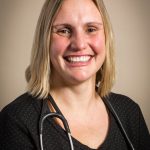By Dr. Ewa Arnold, Grace Cottage Family Health
May is National Women’s Health Month, and I would like to take this opportunity to focus on the importance of Osteoporosis screening for the prevention of fractures. This topic is important to women’s health and deserves more attention.
Osteoporosis affects millions of Americans. It is more common in women than men, and risk increases with age. One in three postmenopausal women has osteoporosis.
Loss of bone mass is an expected part of aging; however, it carries consequences. Osteoporosis develops when bone mineral density and bone mass decrease, or when the structure of the bone changes. This in turn causes bones to become fragile and susceptible to breaking.
Osteoporosis is often called a “silent disease” because it develops over time with few or no symptoms. In the early stages of bone loss patients do not typically have symptoms. Once bones have been weakened by Osteoporosis, patients may experience loss of height over time, posture changes, back pain due to collapsed bones in the spine, or fractures (broken bones). The most common bones that break due to osteoporosis are the wrist, lower back, and hips.
Hip fractures are a very serious problem as we age. People who break a hip might not recover for months or even years. This reduces independence and shortens life. Often people cannot care for themselves following a hip fracture, and they are more likely to have to live in a nursing home. About half the people who have a hip fracture are not able to return to independent living. Broken hips also greatly increase the risk of death, especially in the first year following the fracture.
Throughout our lives, our bodies are constantly breaking down old bones and building up new bones. For most people, the rate of build-up exceeds break-down until approximately age 30-35. Until that point, the body makes new bone faster than it breaks down old bone. As we age and hormone levels drop, the rate of replacement slows down and the rate of break-down increases. This happens to both men and women, but women lose bone mass faster after menopause.
Early screening for Osteoporosis can help to prevent the worst effects of the disease, and with treatment and early intervention, we can reduce the risk of fractures.
Depending on your insurance plan, you may be able to get screened at no cost to you. Medicare may cover bone density tests at no cost.
Under the Affordable Care Act, insurance plans must cover screening for Osteoporosis for women ages 65 years and older, and for women ages 64 years and younger who have gone through menopause and therefore have an increased risk of Osteoporosis. In addition, some other exceptions allow for more frequent bone density scans, including follow-up scans for individuals undergoing treatment for Osteoporosis and for individuals on high-risk medications such as steroids or certain chemotherapy agents.
Grace Cottage’s Radiology Department provides bone density testing services Monday through Friday, 7:00 a.m. to 6:30 p.m.
Bone density screening exams, commonly called DEXA scans, are noninvasive. They require no effort or preparation, and the test only takes about 15 minutes.
During the test, the patient lies comfortably on a table while a licensed Radiologic Technologist uses a machine to acquire images of the patient’s lower back and hip. The patient’s bone density levels are compared to base norms and given a score. This information is forwarded to your medical provider, who will go over the results and, if necessary, discuss treatment.
If your doctor finds that your bones are becoming weaker, there are things you can do to make them stronger. You can become more physically active with a combination of strength training and weight-bearing exercises. If your bones are already weak, there are medicines that stop bone loss. Some can even build new bone and make it less likely that you will suffer broken bones.
It is also important to get enough calcium in your diet. Currently, it is recommended that women over the age of 50 consume at least 1200 mg of calcium. Good sources of calcium include low-fat dairy products, dark green leafy vegetables, canned sardines with bones, canned salmon, and soy products. If you have a hard time getting enough calcium from your diet, you can take a calcium supplement.
It is also important to get enough vitamin D, which helps your body absorb calcium. Post-menopausal women need 800 IU of vitamin D a day. Potential sources of vitamin D are sunlight, as well as some dietary sources, such as cod liver oil, trout, salmon, and Vitamin D fortified milk and cereal products. People who live in areas with limited sun exposure, such as Vermont, may need to supplement.
Why do some people develop Osteoporosis, and some do not? Certain things can raise your risk, including hormone changes, not getting enough calcium and vitamin D in your diet, smoking cigarettes, drinking too much alcohol, not getting enough physical activity, having a low body weight, or having certain diseases, or taking certain medicines. In addition, genetic factors also contribute. Working on risk factor reduction will decrease your chances of Osteoporosis.
In summation, your quality of life is determined by your level of daily activities and your physical health. Osteoporosis can severely disrupt this quality of life. Early screening can help to ensure that you can keep up with the activities you are accustomed to doing, leading to a longer, healthier, happier life!

